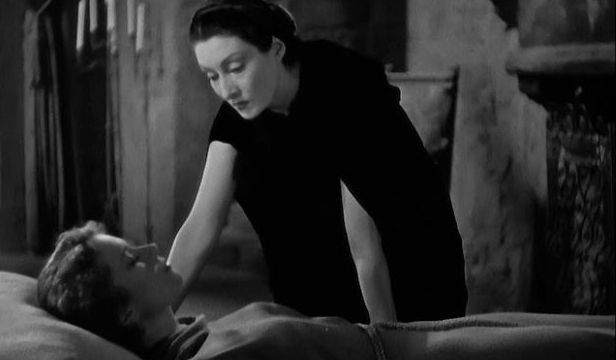I do love these quick-and-dirty kind-of sequels that movie studios used to pump out like crazy, especially when they had a horror franchise Sometimes you would get diminishing results, like the later Hammer Dracula movies with Christopher Lee, but sometimes you get what at first seems just a cheap throwaway but has its own particular pleasure, like 1936’s Dracula’s Daughter.
Use the same forest and castle sets from Dracula (some of them redressed a bit) and a couple of street and living room scenes and bam, you have a setting for the story of Countess Marya Zaleska. At least a hundred years dead (it’s very unclear if she is Dracula’s actual daughter or just his vampiric progeny), she shows up mere moments after Dracula’s death in the previous movie, as Van Helsing is arrested by a pair of British policeman for stabbing Dracula in the chest with a wooden stake. As he defends himself from murder charges by pointing out, quite reasonably, that he was killing a vampire, the local police have a good cheer for him and let him go with their thanks. Hah hah, no, they immediately laugh at him and mock his crazy talk about a Transylvanian bloodsucker.
Meanwhile, Zaleska shows up to the local jail and steals Dracula’s body. Here is where the movie takes an interesting turn for you; she’s not there to resurrect him or steal his essence or what you might expect. She’s there to burn his body in a ritual, salting the fire, so that she is free of the curse of Dracula and free to live as a mortal woman. (Seeing that she’s been undead for a century or so, that should mean she immediately dies, but hey…movie.) Gloria Holden is the center of the movie as Zaleska and she’s magnetic; there’s plenty of stories that she was really annoyed by being assigned this role, and if that disdain led to how she plays Zaleska with a certain remove, it’s a lucky accident. I love how she expresses a certain coldness toward her own condition, wanting nothing more than to be a mortal again while at the same time unable to overcome her own compulsions.
Those compulsions are why she is drawn to Dr. Jeffrey Garth, intrepid psychologist, who’s been recruited to defend Van Helsing against murder charges (a plot that really is only important in terms of giving Garth clues about vampires, like how Zaleska doesn’t have any mirrors). Zaleska wants Garth’s help in confronting her compulsions; unfortunately, his advice is for her to confront them head-on. That doesn’t work out so well for a young woman Zaleska’s assistant finds out on the street, whom Zaleska tells she wants to sketch her head and shoulders in a scene I’m sure The Celluloid Closet had a field day with in just how…charged it was for 1936. The poor woman ends up in the hospital for blood loss, Garth is called in to examine her for…reasons (remember: psychologist and not a medical doctor) and he hypnotizes her to remember a woman with striking eyes and jewelry. AHA! Zaleska is a vampire
Have I mentioned this movie is a whole whopping 71 minutes? At this point, the train has boarded, Garth is making connections like Sherlock hitting his mind palace on meth and it’s time to chase Zaleska to Transylvania! (Oh, and Zaleska kidnapped his annoying flirty assistant to attract him there to be her consort or save her or something, at this point the plot has abandoned such details to speed to the end.) He tracks her, there’s some vaguely weird scenes involving the locals at a wedding noticing a window in Dracula’s castle is lit, Garth catches up with her (right after a scene with the sleeping assistant and Zaleska that’s another for The Celluloid Closet) and she almost seduces him right before her assistant accidentally shoots her in the heart with a wooden arrow after missing Garth. She dies tragically, finally free of the curse of Dracula, fade to the old Universal logo with the little toy plane flying around the globe.
(Takes deep breath)
Look, this movie has the look of one of the slow-paced Universal movies like The Wolf-Man, but it moves. Sometimes, that means certain plot points are glossed over, but nothing ever that important. It’s a monster movie that’s a ton of tun, the last of the first phase of the Universal monster movies and I think one of the best of them. (I actually kind of prefer this to the English-language Dracula, which to me is a bit of a drag.) Some of the humor in it is corny as hell, like the two cut-rate Nigel Bruces who play British policemen in the beginning of the movie. But it is very worth seeing for Gloria Holden as the Countess; she has a layer of sadness to her that completely makes you understand why she inspired the reluctant vampires of Anne Rice 40+ years later. For her, being a vampire isn’t cool or fun; it’s a curse that she would do almost anything to get rid of, and in the end she gets her wish in the worst way, but one that the movie regards almost as a blessing.

